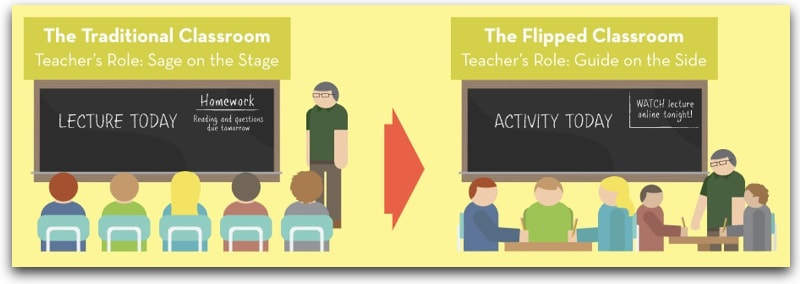Blended Learning
Blended...Hybrid...Flipped...whatever your flavour of online integration may be, this is the page for you! If you want to integrate technology in your classroom, the resources below will provide you with some great ideas. First, let's dive into those terms!
Blended Learning: Students engage in the course content both online and in class. Another term to describe this set-up is Hybrid. The instructor assigns certain learning activities and or assignments for students to complete online. Examples include class discussions, course readings, blog posts, interviews, scavenger hunts, videos, wikis, simulations, etc. The key for instructors to remember is to make explicit connections between the face-to-face and the online. Follow-up on online activities in class and/or ensure there are some graded or participation components to help motivate students to complete the online tasks. And, most importantly, make sure any activities align with your course learning outcomes!
Flipped Classroom: Instructors who use this method take much of what is traditionally done in the classroom (e.g. lectures), and post those tasks online via PowerPoint, online readings, video lecture, etc. Then, in the face-to-face class, there are opportunities for more engaging learning activities, such as discussion, debate, role plays, demonstrations, peer tutoring, feedback, etc. There are many benefits for this model of teaching, including more time in class to assess students' needs, students can control the pace of the readings/lectures, and there is an emphasis on active learning which leads to increased motivation and comprehension of course concepts.
Flipped Classroom: Instructors who use this method take much of what is traditionally done in the classroom (e.g. lectures), and post those tasks online via PowerPoint, online readings, video lecture, etc. Then, in the face-to-face class, there are opportunities for more engaging learning activities, such as discussion, debate, role plays, demonstrations, peer tutoring, feedback, etc. There are many benefits for this model of teaching, including more time in class to assess students' needs, students can control the pace of the readings/lectures, and there is an emphasis on active learning which leads to increased motivation and comprehension of course concepts.
Blended Learning Activities
In addition to the common online activities in blended classes (videos, online lectures, web searches, discussions, blogs), there are other interested activities that can engage your learners and meet the learning outcomes of your lesson. Many of the activities I've listed below are repeated in Learning Activities or Media pages, so be sure to check out those resources. Here are some of my favourites for blended courses:
In addition to the common online activities in blended classes (videos, online lectures, web searches, discussions, blogs), there are other interested activities that can engage your learners and meet the learning outcomes of your lesson. Many of the activities I've listed below are repeated in Learning Activities or Media pages, so be sure to check out those resources. Here are some of my favourites for blended courses:
|
|
Resources for Blended Learning & Flipped Classrooms
Finally, here are some excellent resources for learning online:
Finally, here are some excellent resources for learning online:
- Developing Online Learning Activities for Blended Courses from the University of Waterloo.
- Asks some important questions for using technology in a blended environment, including: What is the learning outcome? How long will the task take? How will the learner get feedback? How will you motivate students to participate?
- Using Learning Activities to Optimize Blended Learning from E-learning
- Lists great activities such as case studies, story mapping, compare & contrast, role play, and games.
- Blended Learning Activities from Linfield College.
- Compares face-to-face approach to online activities, including emailing assignments and feedback, student video presentations, online quizzes and discussions.
- Designing a Blended Learning Course from Concordia. Also see here for some great ideas in planning a blended course.
- Blended Learning Activities from Australian Catholic University: Describes some great examples for a blended class that focus on community building, supporting large groups, developing critical thinking and problem solving skills, and reflection
- Activities include videos, polls, shared maps, virtual lab, slideshow, field trip, peer feedback, and other group work.
- Blended and Online Learning from Vanderbilt University.
- Tips include: know your learner, present a clear path through the material, promote metacognitive awareness, maintain a social presence, promote collaboration, promote active learning, and incorporate media.
- Blended Course Profile from Harvard
- Activities include: Case Studies, Debate, Group Work, Hands-on Labs, Peer Instruction, Project-based Learning, Role-play, Small Group Discussion, and Team-based Problem-solving
- What is Blended Learning? from Bond University
- Videos include how to use Poll Everywhere, nQuio, Prezi, iSpring, PowToon, and VideoScribe.
- Blended Learning Toolkit. A great resource from UCF about organizing content, online activities and assessment strategies.
- Recommended Practices for Use of In-class Time: Great ideas for learning activities.
